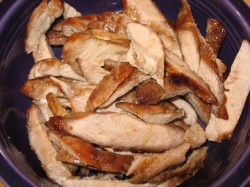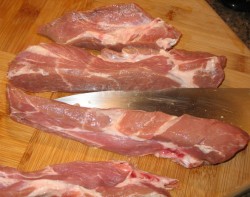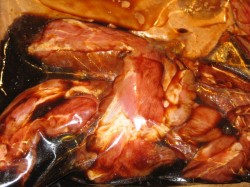A Cantonese Kitchen Classic: Char Siu
Char siu–Cantonese style roast pork–is a classic staple of the southern Chinese kitchen.
But it is a staple that is not often made at home.
Most Chinese home kitchens lacked (and as I understand it, still lack) an oven because ovens require a great deal of fuel to heat properly. So, instead of everyone in a village having an oven, there would be one family who operated an oven, and they specialized in cooking and selling roasted meats: primarily pork and duck.
While most Chinese-American families have ovens, if you go to any North American city where there is a Chinatown, you will notice small shops with whole, red-glazed, deliciously browned ducks hanging from hooks in the windows, alongside brilliantly-hued slabs and strips of crispy-browned char siu. In San Francisco’s Chinatown (a veritable paradise on earth, as far as Zak andI were concerned, especially when it came to food) it seemed as if there was a little roast shop around every corner, or down the twisting alleyways, and in my memory, the enticing fragrance of spiced, glazed meats wafted over every inch of Chinatown.
Even US cities that lack a Chinatown often have one or two restaurants, Chinese groceries or small take out shops that carry roasted meats. Columbus has both CAM–Columbus Asian Market, and Hometown Oriental Gourmet Food, both in the same strip-mall area on Bethel Road. When we lived in Pataskala, which is but a forty minute drive from downtown Columbus, we used to stop in at Hometown Oriental Gourmet Food, visit with the gregarious owners, and sit down to Zak’s favorite meal: roast pork noodle soup, which is good ramen noodles topped with meaty slices of char siu and graceful green tendrils of choy sum, then drowned in liquid gold: rich homemade chicken-pork broth. Actually, Zak usually got the soup, and I got either Singapore rice noodles or king du noodles, which was their take on ja ziang mein. He never finished the broth, so I always got the last cup or so of it: redolent of chicken and pork neck bones, slightly sweet from the char siu’s glaze, and speckled with the house-made chili oil Zak always added to it.
Heaven in a bowl.
We always stopped in there before we headed across the parking lot to CAM, because going to a big Asian supermarket hungry is a bad proposition for the wallet, besides being an exercise in frustration. Before we paid the bill, though, Peter or one of his sisters would ask if we wanted some char siu to take home, and we usually had a pound or two wrapped, and we would stow it in our freezer, in half-pound portions. That way, if I wanted a quick supper, I could thaw out a package, slice it thinly against the grain, and stir fry it with some choi sum, baby bok choy or gai lan. If any was left over, I could cut it more finely and put it into fried rice the next day, with fresh greens, some carrots and maybe some water chestnuts, if CAM had them fresh.
Or, if it was a special holiday, like a birthday or New Year’s, I could make char siu bao–steamed roast pork buns–a perennial favorite among our family and friends.
However, now that we are in Athens, we are not so lucky.
There is no roast pork to be had here.
I suppose that I could ask around at some of the Chinese restaurants and see if they would sell me some, and in truth, they probably would, but I don’t always think about it before I want it.
Which means that I just have to haul off and make it myself.
And, wonder of wonders, while it isn’t any more convenient to do so, the results are quite good, and in many ways, even tastier than what I was getting in Columbus, probably because of the quality of the pork I start out with.
Traditionally, the meat for char siu has to be fairly fatty, because the meat is cut in fairly small hunks or strips (when I say fairly small, I am not talking bite sized–what I mean is that you will not see whole butt or shoulder portions roasting for char siu ) that are hung from hooks so that the very hot air from the oven can touch every part of the meat, crisping the outside and caramelizing the sugary marinade. It is basted several times, allowing a crunchy coating to build up as it cooks, mingling with the ample fat that melts, keeping the meat moist during this very dry cooking method. Leaner cuts of pork would simply shrivel up into unappealing chunks of honey-dipped shoe leather.
For my char sui, I always use pork shoulder from Bluescreek’s organically raised, free range Yorkshire hogs. They have a slightly sweeter flavor than the stronger flavored Durocs that are raised here in Athens–those I prefer for making Mexican carnitas, or for use in posole, chili or pot roasts and stews where there will be plenty of moisture, and bolder spices and flavorings. The pork from Bluescreek, however, is very finely grained, firm, and delicately flavored, with plenty of fat, which makes it perfect for most Asian cooking applications, particularly when it comes to anything Cantonese.
In the past, I have rigged up my oven with a rack placed up high and used “S” hooks from the hardware store to hang meat from holes skewered in the edges, with pan down below to catch drippings, in order to recreate the way in which char siu is cooked in commercial Chinese establishments. And the results are fantastic, but the trouble is only worth it if one is doing a large amount of meat at a time. Which is an admirable way to go about it–make up three to five pounds of it, portion it out and then freeze it for use later.
However, I wasn’t about to go through that riagmarole this weekend just so I could make ten steamed pork buns for Morganna’s birthday party. Instead, I utilized my quick and dirty method to make char siu that ended up with just as tasty a product in a smaller amount, with a lot less trouble.
It involves putting the meat on a roasting rack in a shallow pan or on a rimmed cookie sheet, and roasting it that way. The underside doesn’t get as crispy as it does when it hangs, but it still gets quite caramelized and flavorful, and the result, once it is tucked into a puffy, cloud-like steamed bun with a bit of sauce, is just as wonderful as pork done the traditional way. I also discovered that it turns out really nice pork for lo mein, which is a great quick supper for the first weeknight after a weekend of frenzied kitchen activity.
All you have to do is make the marinade, let the meat steep in it overnight, roast it in a hot oven, and then let it cool before cutting into it. If you cut it up while it is still hot, all of that juicy goodness that the extra fat imparts is lost, and then you end up with sawdust meat coated with sugar, which is not very appetizing, especially after you went to the trouble of cooking it.
One final note: you have no doubt seen that my roast pork is not red on the outside. Traditionally, the red coloring came from the use of saltpeter–sodium nitrate–which preserves the meat and keeps the reddish color of it. (Nitrates are what keep bacon red. Without them, the meat turns an ugly grey color–which is still good to eat, mind you–it is just not appealing.) Most places that make char sui now use red food dye in their marinades to give the meat its characteristic cerise hue, which connotes good fortune and luck. I choose to not use the dye myself, preferring to let the meat take on a more natural golden brown color that I find to be just as appealing and a lot less worrisome than some sort of artificial food coloring. If you want the red color, add liquid food coloring until the marinade is the color you would like–because of the dark ingredients in the marinade, it takes a good bit of the red dye to color it properly, which is why I don’t use it.
Even without the coloring, the marinade is so flavorful and good, I don’t miss the color at all.
The inspriation for this marinade and method came from Eileen Yin-Fei Lo and Barbara Tropp’s recipes; as is usual, I tweaked it here and there, and added more of this and less of that, until it suited me, so now it is a bit different than either of the original recipes it came from.
Char Siu
Ingredients:
2 ¼ pounds moderately fatty pork shoulder or butt
1 ½ tbsp. dark soy sauce
1 ½ tbsp. light soy sauce
1 ½ tbsp. honey
1 ½ tbsp. oyster sauce
2 tbsp. shao Hsing wine
3 ½ tbsp. hoisin sauce
½ tsp. five spice powder (I like Penzey’s brand)
black pepper to taste
red food coloring (optional)
Method:
Cut meat into strips 1 inch thick and seven inches long. Using a fork, tenderize meat by piercing all over. This also allows the sauce to penetrate.
Mix marinade ingredients into a ziplock bag large enough to hold meat.
Place meat in bag, mush it all around in the marinade so it is all covered, then push out all of the air, seal bag and leave it in the refrigerator for several hours, overnight or for twenty four hours.
Preheat oven to 450 degrees. Place roasting rack on rimmed cookie sheet, and drape meat over it. Roast for 20 minutes, until the meat is done. Baste the meat as it cooks a couple of times with some of the marinade. Allow to cool after it is done, then cover and refrigerate until needed.
30 Comments
RSS feed for comments on this post.
Sorry, the comment form is closed at this time.
Powered by WordPress. Graphics by Zak Kramer.
Design update by Daniel Trout.
Entries and comments feeds.






I don’t know if you’ve already posted this, but if not, is there any way you could post how to make the steamed buns? I *adore* char sui bai and don’t have anywhere good around here to get them.
Comment by Jennifer — January 31, 2006 #
Fear not, Jennifer. There will indeed be a post on char sui bai. Indeed, yea and verily, there shall be one on this very blog, tomorrow, as was planned.
Yes, char sui bai, and mushroom buns, too. Just ’cause I could.
And the next day–roast pork lo mein.
Comment by Barbara — January 31, 2006 #
Barbara,
Just posted on the post below regarding scallion pancakes–aak! I can’t stop thinking of them 🙂
I was scanning the news headlines and picked up this article: http://news.yahoo.com/s/afp/20060127/ts_afp/afplifestyleusfood_060127155142
In a nutshell, it’s about a group of people who are opting to rummage through garbage for good leftover food in order to minimize the “waste” of food our society puts out. I really am interested in your opinion on the issue.
Comment by Rose — February 1, 2006 #
I have not made this in years but I remember we put a drip pan on the bottom of the oven, the rack at the uppermost portion of the oven, used simple curtain hooks (the kind with a sharp point on one end) and hung the skewered pork from the oven rack. Now…where did I put those hooks? Looks like I am going to need them again.
Comment by Maureen — February 1, 2006 #
Rose–thank you for the link. I will have something on this later this week. I appreciate it!
Maureen–curtain hooks are perfect for this, yes! I used regular “S” hooks, and just skewered a hole in the meat with a boning knife first, because that was what I had around. Now that I live where there isn’t great char sui that I can go out and buy, I should probably just get curtain hooks so I can roast a few pounds of it at a time and put it in the freezer.
Comment by Barbara — February 1, 2006 #
Barbara – This is a post I’ve been looking for. I’ve been on the lookout for dim sum recipes to make at home, especially for super bowl sunday. I’ve plenty of books on the subject, but somehow I prefer blog posts these days.
What a wonderful post, thank you so much!
Comment by Jenn — February 4, 2006 #
Char Siu – Cantonese roast pork Meathenge style
I’ve been monkeying around Barbara’s Tigers & Straberries for quite a few months, reading posts, checking out recipes and leaving odd comments when possible. I stumbled upon this recipe for Char Siu last Thursday and knew it was for…
Trackback by MeatHenge — February 12, 2006 #
You are not just talented at cooking but also very good at teaching others how to do it. I’ve tried your Char Siu recipe and for the first time in my life I can make Char Siu at home. Wooohoo!!! Thank you so so much for a wonderful post, a detailed recipe and loads of tips too.
Comment by Sylvia — May 18, 2006 #
You are welcome, Sylvia! Thank you for coming and telling me how successful you were at making my recipe–it made my day!
Teaching cookery is one of my greatest passions in life. I think that food and cooking are great conduits through which culture is passed down; when people do not know how to cook, they lose some of their own culture. I don’t like to see that lost, so I try to help people learn how to cook, and keep the civilization of the table going.
Thanks again–and I hope you come back!
Comment by Barbara — May 18, 2006 #
If you use star anise instead of relying on 5 spice powder, you’ll get a much redder char sui without using food coloring. I usually use one or two “petals” per 3 lbs pork shoulder. I also find the flavor from using fresh spices is much better.
Comment by Emily Cartier — July 14, 2006 #
Dear Barbara
I have moved from Melbourne, Australia (which has a plethora of Chinese grocers, restaurants etc) to Banbury, Oxfordshire UK, where there is no Chinese roast meat vendor. I was dying without my weekly dose of char siu and fried rice was never going to be the same.
Thanks very much for the helpful recipe.
Kind regards
Natasha
Comment by Natasha Toholka — July 28, 2006 #
Thank you Emily–I will try that. I have star anise in the freezer to keep it fresh.
Natasha–I am very glad to help out with the recipe–good luck, and please have fun finding all the new exciting nooks and crannies in your food world in the UK. It will be an adventure!
Comment by Barbara — August 1, 2006 #
Dear Barbara
We’re just sitting down to your AWESOME char siu pork. Thanks for sharing the recipe. You’ve really inspired us to start cooking chinese again, and we look forward to trying some of your other recipes…
Louise
Comment by Louise — January 13, 2007 #
I am glad you loved the char siu, Louise!
This coming week (and possibly the next) will be dedicated to a book review of Fuchsia Dunlop’s new book on the cookery of Hunan province and will include presentations of at least three or four recipes from the book. The recipes will be adapted–I am constitutionally incapable of following recipes exactly, but they will still be a fair representation of what one will find in the cookbook.
And the two recipes I have tested so far have been out of this world delicious….so much so that I am really looking forward to adding a lot of Hunan recipes to my mainly Sichuan and Cantonese canon of dishes which I cook on a regular basis.
Comment by Barbara — January 14, 2007 #
I am interested in learning to make the “liquid gold” chicken and pork broth for my pork noodles that I make at home. Without the right broth they don’t taste right. Thank you to anyone who can help me out with a recipe for the broth.
Comment by Crystal — June 26, 2007 #
I am interested in learning to make the “liquid gold” chicken and pork broth for my pork noodles that I make at home. Without the right broth they don’t taste right. Thank you to anyone who can help me out with a recipe for the broth.
Comment by Crystal — June 26, 2007 #
Your recipe is very good, but I believe it is missing two key ingrediants. In my Char Sui I love to add about 1 – 1 1/2 tbs of sesame oil and 2-3 tbs of red bean paste. The paste gives the marinade its’ prerequisite thickness and the oil adds a nice nuttiness to the general sweet character of the marinade.
Comment by Michael Eber — July 7, 2007 #
Next time I make it, I will add your suggested ingredients, Michael. Thanks for the idea!
Comment by Barbara — July 8, 2007 #
For the hooks you can also use really heavy paper clips, such as the ones that are sorta triangular rather than oval.
(I really need to keep track of my “late to the party” posts, if I want to see if there are any responses.)
Comment by Harry — October 19, 2007 #
This looks awesome, Barbara. I am wondering if I can replicate the same results in my ceramic cooker — essentially, a charcoal-fired outdoor oven. My plan is to lay the meat on the grates so there will be certainly be (delicious) grill marks on the meat. Will this be horribly inauthentic? Would I taint it even worse if I added hickory smoke? It sounds delicious to me, and I thought I would inspire your thoughts.
Comment by Jim — October 22, 2007 #
Jim–check out this link from Meathenge, where Dr. Biggles took my recipe and used it in his smoker.
http://www.cyberbilly.com/meathenge/archives/000991.html
By all accounts, and by my reckoning, it turned out extra special tasty and good, so I suggest you give your method a try and see what happens.
And let me know how it tastes, and post your results (or a link to them) here so other folks can hear about it to.
I love it when people adapt my recipes!
Comment by Barbara — October 22, 2007 #
Hi! My friend emailed me this recipe a while ago and I finally made (part of) it last night – the pork is marinating in my fridge as I type this! My only problem is that I ended up making it in chunks instead of strips because there was a bone in the middle of the piece of meat that i bought – and now it won’t stay on the roasting rack without falling through the “slats”. Do you have any suggestions? I’m now contemplating rigging something up using paper clips in my oven, but that sounds so labor intensive….argh!
Comment by Lara — April 28, 2008 #
Hi, looks great ! I was told that prior to the grand entrance to the oven, a pan of water has to be placed beneath the rack that will be used later for the char siu. So that there will be steam. Whats ur advice?
Comment by Marcus — September 9, 2008 #
Barbara,
I’m planning on making this recipe tomorrow in my charcoal oven, but I have one reservation about the recipe. In the recipe, you indicate that the meat should be basted a couple of times with the marinade. Is this a health risk, given that the raw meat was sitting in the marinade overnight? I see a couple of ways of avoiding this risk:
1. Bring the marinade to a simmer before basting
2. Allow sufficient cooking time after the last basting to ensure food safety
Let me know what your thoughts are.
Comment by Jim — January 14, 2009 #
Jim, go ahead and bring the marinade to a boil before you baste it.
That should take care of any issues.
Comment by Barbara — January 14, 2009 #
Hi Barbara,
I truly cannot wait to make this recipe, as in I’d be making the marinade right now, except for one lingering question- I’m wondering if you tried Michael’s additions of sesame oil and red bean paste?
Some recipes insist that especially the paste makes a real difference in recreating the flavor that I have come to miss as a displaced San Franciscan.
Thanks for your time!!
Comment by Karen — January 18, 2009 #
You’ll be happy to know that I just pulled my made fer Lunar New Year char sui out of the freezer for Memorial Day sandwiches on hamburger buns. Think I’ll sautee some baby bok choy to throw on top o it too. I always find your blog inspirational.
Thanks so much!
Comment by Vettie — May 20, 2009 #
Hi Barbara,
I read your last post a while back..I really hope that you’re steadily approaching your goal. Best wishes & hugs!
with that said..I’ve put my pork in the fridge with the marinade tonight. And I have S hooks but no roasting rack! (odd, I know) If I do the S hook method, is the oven temperature/roasting time the same as above? Would I need to baste the meat more frequently?
Thank you!
Comment by Yoko — April 7, 2010 #
[…] Recipe | MyRecipes.comChar Siu (Chinese BBQ Pork) Recipe – No Recipes – Techniques …Tigers & Strawberries » A Cantonese Kitchen Classic: Char SiuChar Siu Pork Recipes – Food.comSteamed buns with roast pork filling (Steamed pork buns, or […]
Pingback by Weekly Special: vegan Char Siu | Vegan Vegetarian — December 13, 2011 #
[…] duurt ongeveer net zolang door de slechte parkeergelegenheid in de buurt. Ik met mijn goede gedrag een recept uitgezocht op […]
Pingback by Boeit mij het ? » Als de toko je kruiden niet heeft — July 21, 2012 #